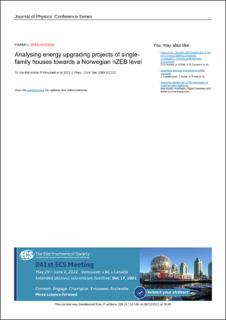| dc.description.abstract | As the existing building stock is responsible for high energy use and greenhouse gas emissions, energy upgrading projects have been acknowledged as crucial for the energy performance improvement of existing buildings, as well as for environment preservation and rational use of resources. The aim of this article is to investigate the definition of a nearly zero-energy building (nZEB) level for the energy upgrading of single-family houses. In particular, the findings from a research project, i.e., "energy upgrading of wooden dwellings to nearly zero energy level" (OPPTRE), are presented and discussed. A core task of OPPTRE was to carry out an architectural competition, where six interdisciplinary teams proposed innovative solutions for upgrading to a nZEB level representative Norwegian wooden single-family houses, from the period 1950-1990. The upgrading measures proposed in the OPPTRE competition focused on several aspects, such as architectural quality, indoor thermal environment, energy use/generation, carbon footprint, and cost effectiveness. General principles for a nZEB level achievement in upgrading projects are discussed in this article, as deducted from the evaluation of the results of the OPPTRE architectural competition. In particular, the focus is on examining the solutions proposed for upgrading building envelope and technical building systems. Energy use, energy generation, investment costs, and CO2 emissions are examined across the various OPPTRE projects, striving to define a trade-off among different parameters for the achievement of a nZEB level. The findings of this paper support the creation of knowledge in nearly zero-energy upgrading of wooden single-family houses, aiming to a more systematic definition of a nZEB level in such projects. This can be relevant for several stakeholders, such as governmental institutions, homeowners, builders, and private or public decision makers, towards the market uptake of nZEB upgrading by 2030. | |

